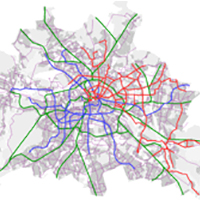From Rail-Oriented to Automobile-Oriented Urban Development and Back. 100 Years of Paradigm Change and Transport Policy in Berlin
Abstract
Transport and its side effects are major problems in rapidly growing cities. Car traffic dominates these cities and pollutes the environment without being able to sufficiently secure the mobility of the urban population and goods. A paradigm shift in urban and transport policy will be necessary to change this situation. In spite of its different development dynamics, Berlin is an interesting example to discuss development strategies for rapidly growing cities because in the course of more than 100 years, a twofold paradigm shift has occurred in the city both conceptually and practically: Berlin has shifted from a city dominated by rail traffic to an automobile-oriented city, and has then gradually transformed back into a city in which an intertwined system of public and non-motorized individual means of transport secures the mobility of the urban population. The interdependencies on the conceptual level between urban planning and transport policies as well as on a practical level between urban structures and transport systems can be studied using the example of Berlin. Experiences with the implementation of automobile-oriented planning and the special conditions in the first decade after reunification led to protests, reflection, and a revision of the transport policy. A strategically designed process of integrated planning has brought about a trend reversal, and steered the development of transport in the direction of clearly formulated sustainability-oriented objectives. In this process, the reintegration of transport and spatial planning and a reorganization of institutional structures at the administrative level was of particular importance. Compact, rail-oriented settlement structures like in the metropolitan region of Berlin make it easier to dispense with automobiles than sprawled structures. The residual role that qualitatively improved automobiles will take in the cities of the future will have to be determined by research and practice. What is certain is that an attractive public transport system should form the backbone of urban transport services.Downloads
References
Habitat III (2015). Issue paper 19 on transport and mobility (draft version 2.0). United Nations Conference on housing and sustainable urban development, New York.
Kalender, U. (2012). Die Geschichte der Verkehrsplanung Berlins. Archiv für die Geschichte des Straßen- und Verkehrswesens – Heft 24 Forschungsgesellschaft für Straßen- und Verkehrswesen. FGSV-Verlag: Köln.
Köhler, T., Von Buttlar, A., Müller, U. Köhler, T., Flierl, B., Frank, H., Heckmann, A. M., Leinauer, I., von Moos, S., Müller, U., Seehausen, F., Weilemann, D. (2015). Radically modern: urban planning and architecture in 1960s Berlin, on the occasion of the exhibition Radically Modern. Planning and Contruction on 1960s Berlin, 29.05. to 26.10.2015. Tübingen: Wasmuth.
Kuhnimhof, T., Buehler, R., & Dargay, J. (2011). A new generation: travel trends for young Germans and Britons. Transportation Research Record: Journal of the Transportation Research Board, 2230, 58-67. doi:http://dx.doi.org/10.3141/2230-07.
Kunst, F. (2014). Stadt und Auto – ein Konfliktverhältnis. Stadtbauwelt, 202, 17-23.
Kutter, E. (2005). Entwicklung innovativer Verkehrsstrategien für die mobile Gesellschaft: Aufgaben, Maßnahmenspektrum, Problemlösungen. Erich Schmidt Verlag GmbH & Co.
Kutter, E. (2015). Stadtplanung was nun?: Situation der stadtregionalen Planung nach der Individualisierung des Verkehrs (Teile 1 und 2). Verkehr und Technik, 68(8&9).
Mobil 2010 (2014), City development plan traffic Berlin, Senate Department for urban Development Berlin, Berlin 2003; Urban transportation development plan 2025, Senate Department for urban development and the environment, Berlin 2014 (summary of 2nd revised edition).
Mobilitätssteckbrief für Berlin (2013). Forschungsprojekt Mobilität in Städten -SrV 2013. Retrieved from: www.tu-dresden.de/srv2013.

Copyright (c) 2016 Tema. Journal of Land Use, Mobility and Environment

This work is licensed under a Creative Commons Attribution 4.0 International License.
Authors who publish in this journal agree to the following:
1. Authors retain the rights to their work and give in to the journal the right of first publication of the work simultaneously licensed under a Creative Commons License - Attribution that allows others to share the work indicating the authorship and the initial publication in this journal.
2. Authors can adhere to other agreements of non-exclusive license for the distribution of the published version of the work (ex. To deposit it in an institutional repository or to publish it in a monography), provided to indicate that the document was first published in this journal.
3. Authors can distribute their work online (ex. In institutional repositories or in their website) prior to and during the submission process, as it can lead to productive exchanges and it can increase the quotations of the published work (See The Effect of Open Access)
